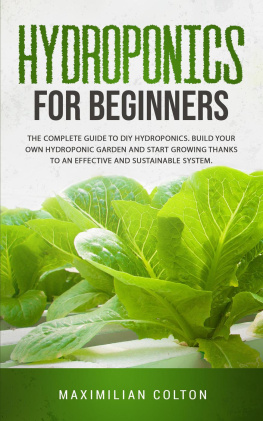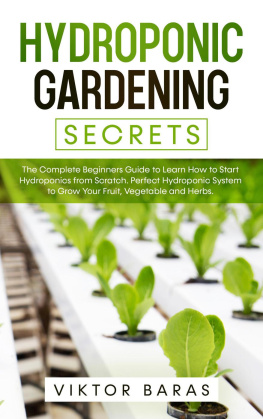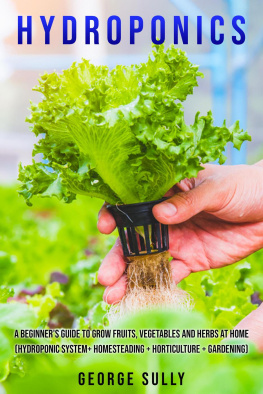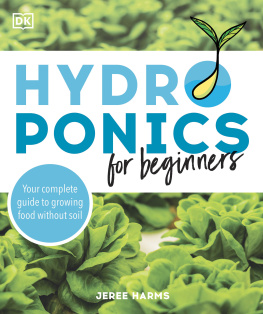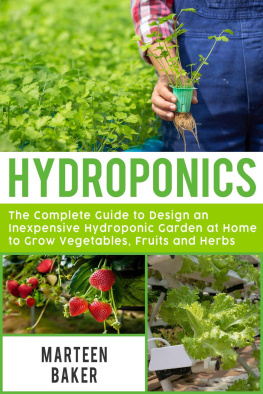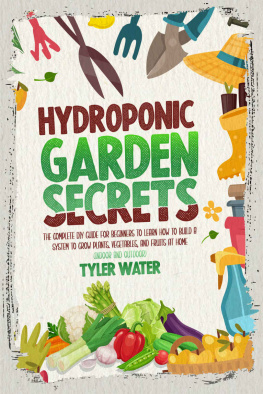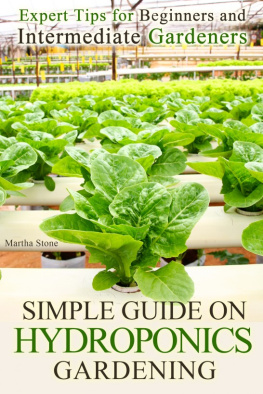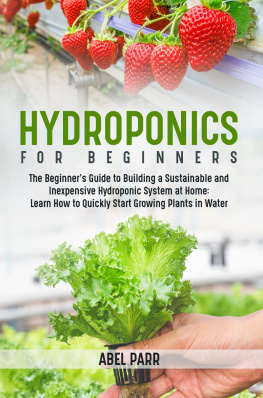Gardening: Hydroponics -
Learn the Amazing Art of Growing: Fruits, Vegetables, & Herbs, without Soil
Michael I. Rich
Table of Contents
Introduction
Chapter 1: All About Hydroponics
Chapter 2: About Hydroponic Systems
Chapter 3: Choosing the Right Medium
Chapter 4: Mixing Hydroponic Nutrients
Chapter 5: Commercial Hydroponic Enterprise
Conclusion
Copyright 2016 - All rights reserved.
In no way is it legal to reproduce, duplicate, or transmit any part of this document in either electronic means or in printed format. Recording of this publication is strictly prohibited and any storage of this document is not allowed unless with written permission from the publisher. All rights reserved.
The information provided herein is stated to be truthful and consistent, in that any liability, in terms of inattention or otherwise, by any usage or abuse of any policies, processes, or directions contained within is the solitary and utter responsibility of the recipient reader. Under no circumstances will any legal responsibility or blame be held against the publisher for any reparation, damages, or monetary loss due to the information herein, either directly or indirectly.
Respective authors own all copyrights not held by the publisher.
Legal Notice:
This book is copyright protected. This is only for personal use. You cannot amend, distribute, sell, use, quote or paraphrase any part or the content within this book without the consent of the author or copyright owner. Legal action will be pursued if this is breached.
Disclaimer Notice:
Please note the information contained within this document is for educational and entertainment purposes only. Every attempt has been made to provide accurate, up to date and reliable complete information. No warranties of any kind are expressed or implied. Readers acknowledge that the author is not engaging in the rendering of legal, financial, medical or professional advice.
By reading this document, the reader agrees that under no circumstances are we responsible for any losses, direct or indirect, which are incurred as a result of the use of information contained within this document, including, but not limited to, errors, omissions, or inaccuracies.
Introduction
I would like to thank you for choosing this book Gardening: Hydroponics Learn the Amazing Art of Growing: Fruits, Vegetables, & Herbs, without Soil
Hydroponics is the method of growing plants without soil, but in different mediums like sand, gravel or even liquid, with additional nutrients. The aim of this book is to provide you with information that will help you pick a method that would work for you. You will learn about the different methods of hydroponics, how to build your own hydroponic system, the type of nutrients you can use, how to plant your own hydroponic garden, how to maintain it and then the common problems and the ways in which you can correct them. Hydroponic gardening let's you enjoy produce at its best, extremely fresh and full of nutrients.
The procedures that are listed in the book you will be able to grow produce of your own at a fraction of the cost that you purchase them for from your local supermarket. This book doesn't have any superfluous scientific information that would only confuse you; this is a beginners guide to hydroponics, for hobbyists and also those looking to build a hydroponics garden that is commercially viable. So, without further ado let us get started!
Well before we begin, here is a GIFT from the publisher as a thank you for buying this book.
The Ultimate Salad Recipe Collection
More than 350 easy-to-follow recipes, including both classic favorites and fresh new ideas.
Inside you'll find salads designed to suit any occasion throughout the year -- from a summer barbecue to an elegant dinner with family or friends.
Click right here and get it now, FREE!

Hope you liked your gift. Let us now get started with Hydroponics.
Chapter 1: All About Hydroponics
The word hydroponics is derived from Latin and it literally means working water. The simplest explanation of hydroponics would be the process of growing plants without planting them in soil.
History
The art of hydroponics has been around for centuries, its at least as old as the pyramids! One of the Seven Wonders of the World, The Hanging Gardens of Babylon, made use of a rudimentary form of hydroponics. Rice has been grown around the world by making use of this technique since the ancient times.
In the year 1934, this technique made use of for growing other crops by a professor at the University of California. The result of this experiment was 25 feet long tomato vines that had to be harvested by making use of ladders. This is how modern hydroponics had come into being and it has been developing ever since. During the Second World War, this technique was made use of for growing vegetables, for feeding the Allied soldiers, on the air force and naval bases in the South Pacific region.
Today, hydroponic systems are being made use of for feeding millions of people living in the arid regions of Israel, Lebanon, and Kuwait as well as the islands of Ceylon, Philippines and Canaries. Did you know that more than half of the tomatoes harvested in Vancouver Island and one fifth of the tomato crop in Moscow are produced by making use of hydroponics? There are well-developed hydroponic systems aboard the American nuclear submarines and Russian space stations as well. Even the remotest of regions on this earth make use of this technique for domestic purposes.
Hydroponic installations are being use on large scale by commercial producers as well.
Is this meaningful?
Gardeners are really fond of hydroponics, because they can grow most of the things they would like to without having to put in back breaking physical effort, they dont have to till the ground, dont have to rake or hoe it, no vermin or pests/insects they need to watch out for and they also dont need to pull out weeds or make use of poisonous pesticides and insecticides.
Hydroponics is best suited for hobbyists who dont have time or space for maintaining a fully-fledged soil garden. During spring and summer you can shift the portable hydroponic system onto a porch or a balcony so that they can absorb natural sunlight and in winter the same unit can be placed somewhere inside the house where you can make use of artificial light for growing the plants.
Plants grow better in this technique because their roots need not compete with one another for the nutrients and they dont have to push through layers of soil either. Plants need air to breathe and grow, just like we do, and the porous aggregate thats made use of in hydroponics assist in free circulation of air. This result in a better growth of hydroponic plants, they tend to ripen earlier and provide a better yield as well, when compared to plants grown in soil.
The fruits and vegetables that are grown by making use of this technique are more nutritive and flavorful as well. Hydroponic vegetables usually end up in the gourmet produce section and are sold for higher prices than the ordinary vegetables. The point here is that you can grow the same vegetables in your backyard for a lesser cost.
Why choose hydroponics?
You might have noticed that there is something thats missing in the vegetables purchased from a supermarket. Well, its the flavor. Like with many other foods, flavor has been bartered for the sake of producers convenience. In a bid to improve the quantity of the produce, the quality of the produce is being compromised. One of the main reasons for this loss is the seeds that are being developed for this so called agribusiness. These seeds are meant to produce high yields and fast growth.


